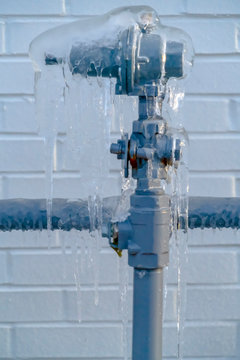We've noticed this article involving Winter Plumbing Precautions: Preventing Frozen Pipes listed below on the net and felt it made perfect sense to share it with you in this article.
:strip_icc()/snow-outdoor-faucet-pipes-4af65d1e5e904fb1aa7bf74071fe5d89.jpg)
Winter can damage your pipes, particularly by freezing pipelines. Below's exactly how to avoid it from occurring and what to do if it does.
Introduction
As temperatures drop, the risk of icy pipes increases, possibly resulting in costly fixings and water damages. Understanding exactly how to stop frozen pipelines is essential for house owners in cool climates.
Prevention Tips
Insulating vulnerable pipes
Cover pipes in insulation sleeves or utilize heat tape to shield them from freezing temperatures. Concentrate on pipes in unheated or exterior areas of the home.
Heating strategies
Maintain interior areas adequately heated up, particularly locations with pipes. Open up cupboard doors to allow warm air to distribute around pipelines under sinks.
Exactly how to recognize frozen pipelines
Search for decreased water circulation from faucets, uncommon odors or noises from pipes, and noticeable frost on subjected pipelines.
Long-Term Solutions
Architectural modifications
Think about rerouting pipelines far from exterior walls or unheated locations. Include extra insulation to attic rooms, basements, and crawl spaces.
Updating insulation
Buy high-grade insulation for pipelines, attic rooms, and walls. Appropriate insulation aids keep constant temperature levels and reduces the threat of icy pipes.
Securing Outside Pipes
Garden tubes and outdoor taps
Disconnect and drain pipes yard hoses before winter. Install frost-proof spigots or cover exterior taps with protected caps.
Understanding Icy Pipelines
What creates pipes to ice up?
Pipelines ice up when exposed to temperature levels listed below 32 ° F (0 ° C) for extended durations. As water inside the pipes freezes, it expands, putting pressure on the pipeline walls and potentially causing them to break.
Threats and problems
Frozen pipelines can lead to supply of water disruptions, building damages, and expensive repair work. Burst pipes can flooding homes and cause comprehensive architectural damages.
Indications of Frozen Pipes
Determining icy pipes early can prevent them from rupturing.
What to Do If Your Pipelines Freeze
Immediate actions to take
If you believe icy pipes, keep taps available to relieve stress as the ice thaws. Utilize a hairdryer or towels soaked in warm water to thaw pipelines slowly.
Verdict
Stopping icy pipelines calls for positive measures and quick feedbacks. By understanding the causes, signs, and safety nets, property owners can safeguard their pipes throughout cold weather.
6 Proven Ways to Prevent Frozen Pipes and Protect Your Home
Disconnect and Drain Garden Hoses
Before winter arrives, start by disconnecting your garden hoses and draining any remaining water. Close the shut-off valves that supply outdoor hose bibs and leave the outdoor faucet open to allow any residual water to drain. For extra protection, consider using faucet covers throughout the colder months. It’s also important to drain water from any sprinkler supply lines following the manufacturer’s directions.
Insulate Exposed Pipes
Insulating your pipes is an effective way to prevent freezing. Pipe insulation is readily available at home improvement stores and is relatively inexpensive. Pay close attention to pipes in unheated areas such as the attic, basement, crawl spaces, or garage. Apply foam insulation generously to create a buffer against the cold. You can also wrap your pipes in heat tape or thermostat-controlled heat cables for added warmth.
Seal Air Leaks
Inspect your home for any cracks or openings that could let in cold air. Seal any holes around the piping in interior or exterior walls, as well as the sill plates where your home rests on its foundation. Additionally, make sure to keep your garage door closed unless you’re entering or exiting. Leaving it open creates a significant air leak that can lead to frozen pipes.
Allow Warm Air Circulation
During cold snaps, it’s essential to allow warm air to circulate evenly throughout your home. Leave interior doors ajar to promote better airflow. Open kitchen and bathroom cabinets to help distribute heat consistently around the rooms. If you have small children or pets, be sure to remove any household chemicals or potentially harmful cleaners from open cabinets for safety.
Let Faucets Drip
A small trickle of water can make a big difference in preventing ice formation inside your pipes. When temperatures drop significantly, start a drip of water from all faucets served by exposed pipes. This continuous flow helps prevent the water from freezing. Additionally, running a few faucets slightly can relieve pressure inside the pipes, reducing the chances of a rupture if the water inside does freeze.
https://choateshvac.com/6-proven-ways-to-prevent-frozen-pipes-and-protect-your-home/

I'm just very intrigued by How To Avoid Freezing Pipes and I hope you appreciated our page. Enjoyed our blog? Please share it. Let another person locate it. Thanks a lot for going through it.
Click Here